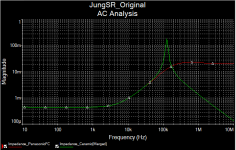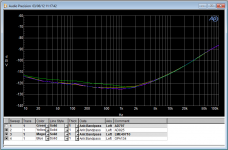Tried 10mA and that was marginal.
After looking at the BC556B and AD817 data sheet I've increased the current source current to 20mA as that's well below the +-50mA source / sink rating of the opamp and my load will be constant around 500mA.
Works great now! 2.5V across the zener and stable.
So you halved the value to R1 to 120R to increase the source current?
HI just about to order resistors for R7 R8 R13 R14
if i go with the bom and use 4 x 1K will that give me 15v?
if i go with the bom and use 4 x 1K will that give me 15v?
It will, of course, give you twice the reference voltage.
Hint: the two inputs of the opamp want to be equal.
Jan
Hint: the two inputs of the opamp want to be equal.
Jan
So you halved the value to R1 to 120R to increase the source current?
There is about 1.4V across the source resistor so you can size to give the current you want. 70R gives 20mA.
Hi All,
I just came across this thread after reading this document and had a
few questions.Op-Amp Based Linear Regulators
The circuit schematic posted on the 4/2000 by Walt Jung shows the use of a LM317 / LM337 as a pre regulator.
Q1. Why was the pre regulator not included on the boards that are for sale in the DIY audio store?
The results of article published by 'Jack Walton's Linear Audio Vol 4'
https://linearaudio.nl/sites/linearaudio.net/files/v4 jdw.pdf
suggested that
I don't see this op-amp in the BOM included in the boards that are for sale in the DIY audio store?
Q2. Why was the AD797 not the recommend op-amp?
I just came across this thread after reading this document and had a
few questions.Op-Amp Based Linear Regulators
The circuit schematic posted on the 4/2000 by Walt Jung shows the use of a LM317 / LM337 as a pre regulator.
Q1. Why was the pre regulator not included on the boards that are for sale in the DIY audio store?
The results of article published by 'Jack Walton's Linear Audio Vol 4'
https://linearaudio.nl/sites/linearaudio.net/files/v4 jdw.pdf
suggested that
In terms of noise, the AD797 still wins when compared to this cohort of operational amplifiers.
I don't see this op-amp in the BOM included in the boards that are for sale in the DIY audio store?
Q2. Why was the AD797 not the recommend op-amp?
Hi All,
The results of article published by 'Jack Walton's Linear Audio Vol 4'
https://linearaudio.nl/sites/linearaudio.net/files/v4 jdw.pdf
suggested that
I don't see this op-amp in the BOM included in the boards that are for sale in the DIY audio store?
Q2. Why was the AD797 not the recommend op-amp?
Both Walt Jung and myself repeatedly had issues with the 797 as to stability in this application. The 797 is a superb opamp and very low noise, it just was very hard to keep it stable. I have no clear explanation why this is so; it may have something to do with its unique internal structure.
Jan
Thanks Jan.Both Walt Jung and myself repeatedly had issues with the 797 as to stability in this application. The 797 is a superb opamp and very low noise, it just was very hard to keep it stable. I have no clear explanation why this is so; it may have something to do with its unique internal structure.
Jan
Well I'm definitely not going to argue with that. I appreciate your prompt response.
What about the LME49710 can that be used?
Are you able to Answer question one at this time?
Last edited:
Good luck, Mark.I'm trying an AD797 power supply board this week. Unity gain! Wish me luch.
From what I've read this is definitely a great regulator as I'm sure you know.
..
I don't see this op-amp in the BOM included in the boards that are for sale in the DIY audio store?
Q2. Why was the AD797 not the recommend op-amp?
Nowadays I think you can find half a dozen of ultra low noise opamp with much more "modern" performance.
A prereg would add more stuff on the board without really having a worthwhile impact on the output quality, so we never really considered to add it.
But you can always add it at the front if you want of course.
Jan
But you can always add it at the front if you want of course.
Jan
But you can always add it at the front if you want of course.
Are there Gerber files available anywhere?
If not, if I was to draw something up in sprint layout. Would you mind checking it?
Hi Mark,
Just wondering what the rest of your circuit looks like, for your power supply. What did you use for your transformer, rectifiers, storage capacitors etc. Before and after the Super Regular?
Just wondering what the rest of your circuit looks like, for your power supply. What did you use for your transformer, rectifiers, storage capacitors etc. Before and after the Super Regular?
It was long long ago and those boards have been scavenged. From memory it was probably a Triad split bobbin "World Series" transformer with dual primaries and dual secondaries. Something like 2x15VAC rated 30 or 50VA. I probably used UF4004 or MUR460 diodes, and low-ESR filter capacitors from Panasonic. No snubbers; even though I had read Jim Hagerman's paper, I didn't have the tools to measure transformer leakage inductance back then. I didn't hang any extra capacitors on the Super Regulator output but I think I did connect bleeder resistors from output to ground, chosen such that their DC current would be 15 or 20mA. Just to keep a healthy current flowing in the output transistors at all times. After all, the regulator circuit's open loop output impedance is inversely proportional to output current. The greater the current the lower the impedance. Does it really matter? I didn't conduct before-and-after listening tests to find out.
What about the LME49710 can that be used?
Attachments
Forgive me if this has already been asked.
Does anyone have experience using either the OPA1641 or OPA1611 in this regulator? I ask because I have extras of both in the parts bin. Based on a datasheet comparison of them to the LME49710, they both seem close enough to work, especially the OPA1611. Of course, a datasheet comparison is usually enough, but I would love to hear about real life experience, if possible.
Thanks.
Jac
Side bar - the LME49710 is getting harder to find.
Does anyone have experience using either the OPA1641 or OPA1611 in this regulator? I ask because I have extras of both in the parts bin. Based on a datasheet comparison of them to the LME49710, they both seem close enough to work, especially the OPA1611. Of course, a datasheet comparison is usually enough, but I would love to hear about real life experience, if possible.
Thanks.
Jac
Side bar - the LME49710 is getting harder to find.
Last edited:
- Home
- The diyAudio Store
- Super Regulator

